Report on Study Skills for Higher Education: Goals and Learning
VerifiedAdded on 2023/01/18
|7
|1350
|77
Report
AI Summary
This report delves into the crucial aspects of study skills essential for success in higher education. It begins by exploring various learning styles, including visual, auditory, and kinesthetic learners, and how these styles impact information absorption and retention. The report then examines effective learning strategies and techniques to improve memory retention, such as focusing on concentration, structuring study plans, and avoiding cramming. Furthermore, it outlines the importance of setting both short-term and long-term goals to achieve academic and professional success, providing examples and strategies for goal planning and achievement. The report emphasizes the significance of recognizing individual learning styles and implementing appropriate strategies for optimized learning outcomes. Finally, it underscores the need for structured planning and consistent review to achieve set goals.
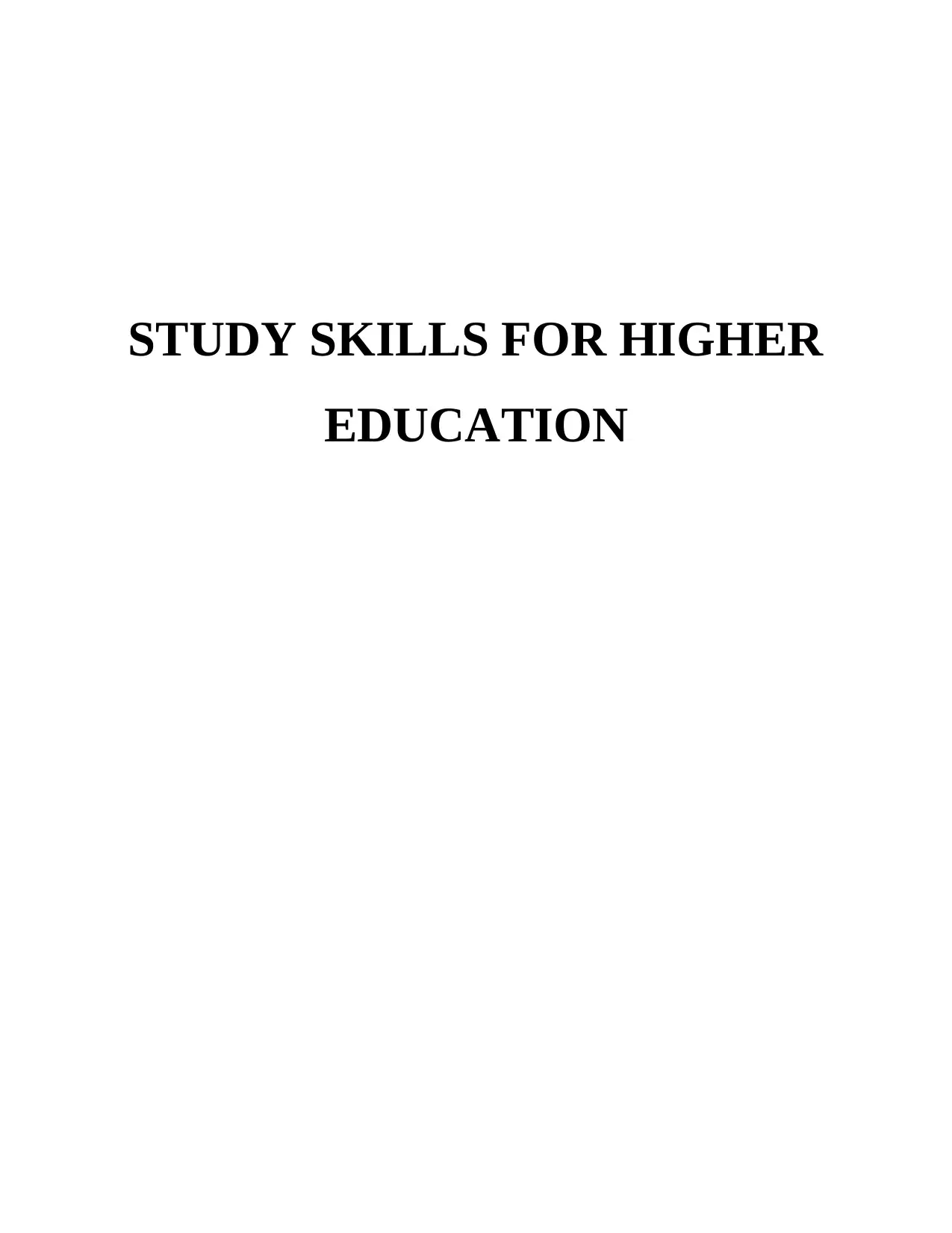
STUDY SKILLS FOR HIGHER
EDUCATION
EDUCATION
Paraphrase This Document
Need a fresh take? Get an instant paraphrase of this document with our AI Paraphraser
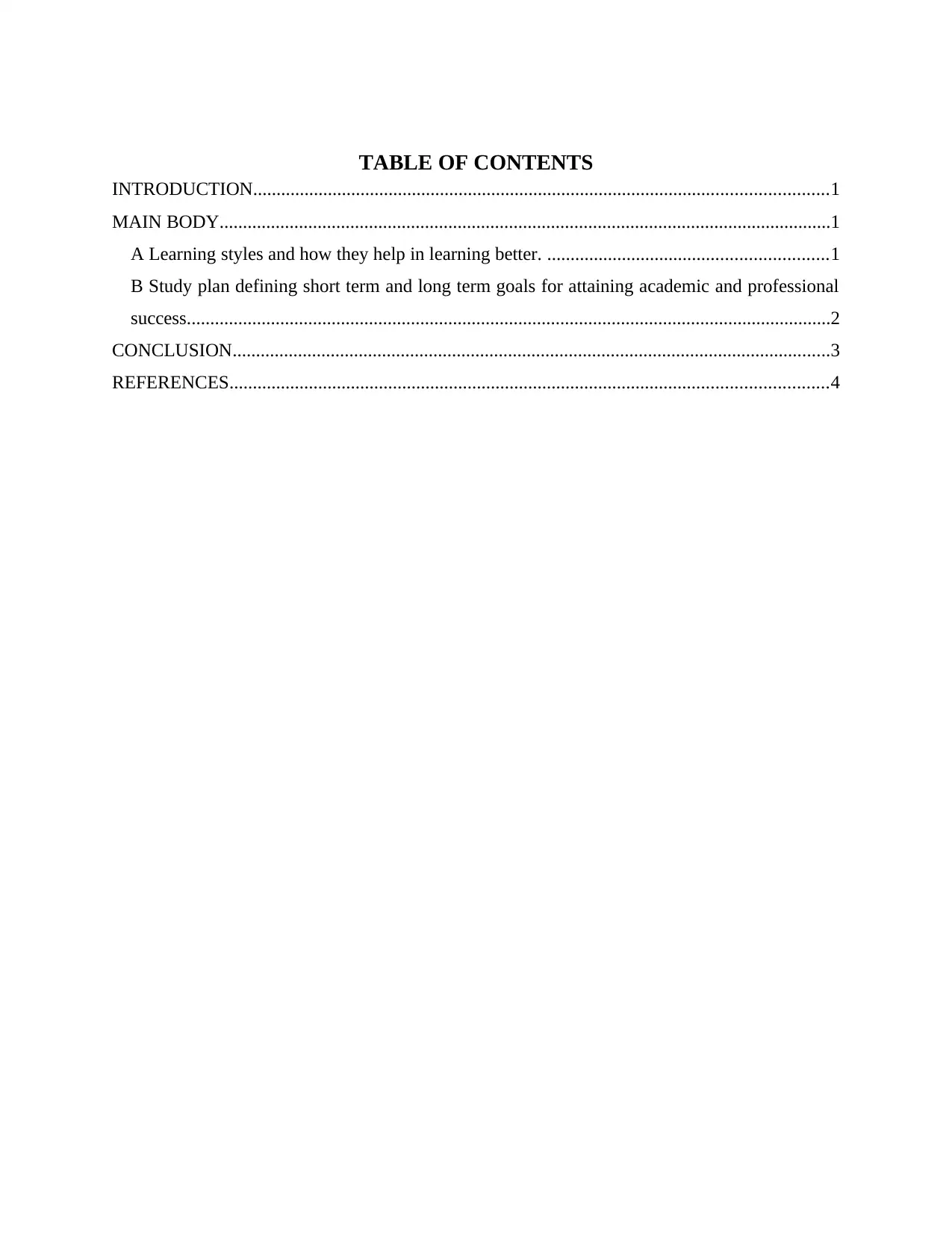
TABLE OF CONTENTS
INTRODUCTION...........................................................................................................................1
MAIN BODY...................................................................................................................................1
A Learning styles and how they help in learning better. ............................................................1
B Study plan defining short term and long term goals for attaining academic and professional
success..........................................................................................................................................2
CONCLUSION................................................................................................................................3
REFERENCES................................................................................................................................4
INTRODUCTION...........................................................................................................................1
MAIN BODY...................................................................................................................................1
A Learning styles and how they help in learning better. ............................................................1
B Study plan defining short term and long term goals for attaining academic and professional
success..........................................................................................................................................2
CONCLUSION................................................................................................................................3
REFERENCES................................................................................................................................4
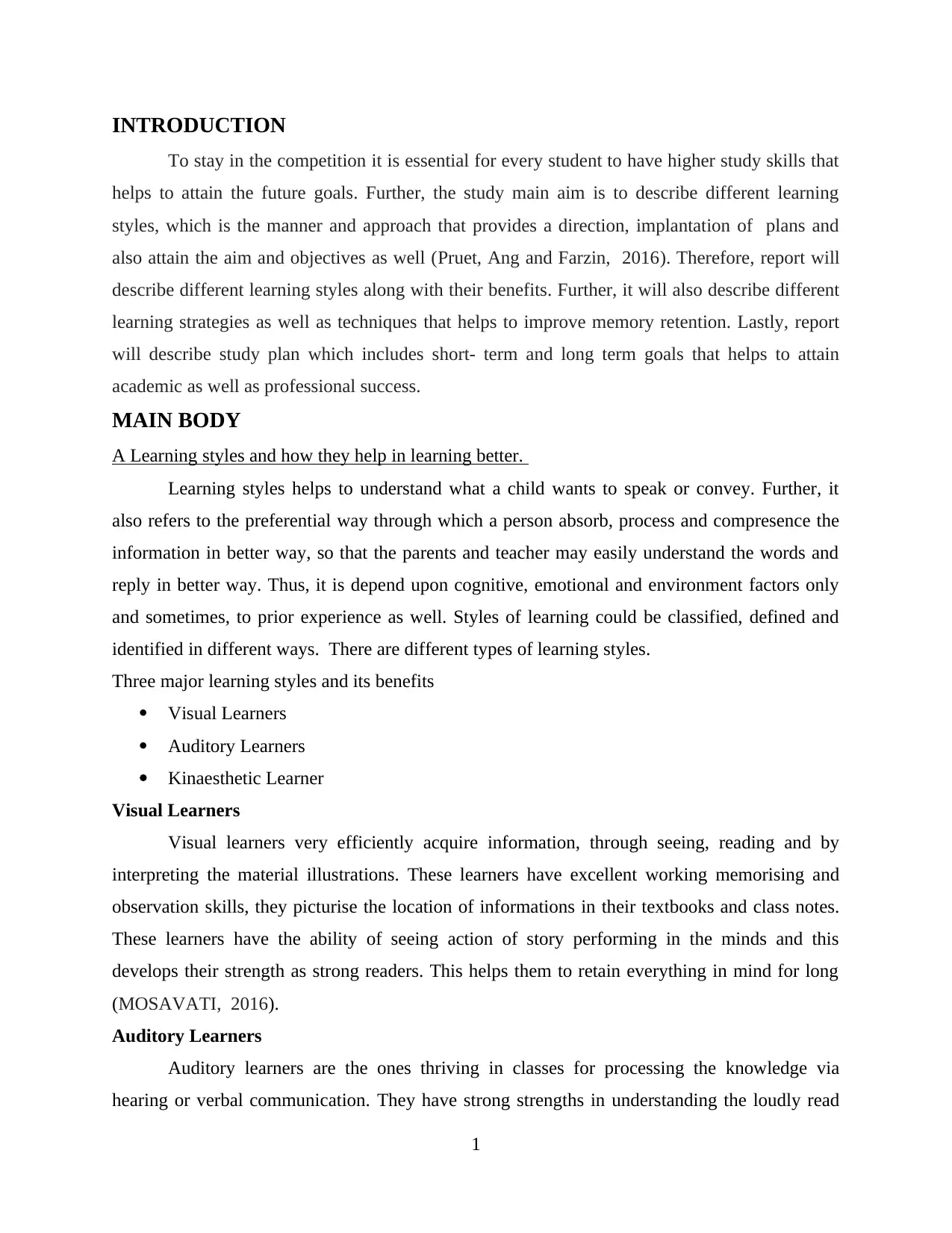
INTRODUCTION
To stay in the competition it is essential for every student to have higher study skills that
helps to attain the future goals. Further, the study main aim is to describe different learning
styles, which is the manner and approach that provides a direction, implantation of plans and
also attain the aim and objectives as well (Pruet, Ang and Farzin, 2016). Therefore, report will
describe different learning styles along with their benefits. Further, it will also describe different
learning strategies as well as techniques that helps to improve memory retention. Lastly, report
will describe study plan which includes short- term and long term goals that helps to attain
academic as well as professional success.
MAIN BODY
A Learning styles and how they help in learning better.
Learning styles helps to understand what a child wants to speak or convey. Further, it
also refers to the preferential way through which a person absorb, process and compresence the
information in better way, so that the parents and teacher may easily understand the words and
reply in better way. Thus, it is depend upon cognitive, emotional and environment factors only
and sometimes, to prior experience as well. Styles of learning could be classified, defined and
identified in different ways. There are different types of learning styles.
Three major learning styles and its benefits
Visual Learners
Auditory Learners
Kinaesthetic Learner
Visual Learners
Visual learners very efficiently acquire information, through seeing, reading and by
interpreting the material illustrations. These learners have excellent working memorising and
observation skills, they picturise the location of informations in their textbooks and class notes.
These learners have the ability of seeing action of story performing in the minds and this
develops their strength as strong readers. This helps them to retain everything in mind for long
(MOSAVATI, 2016).
Auditory Learners
Auditory learners are the ones thriving in classes for processing the knowledge via
hearing or verbal communication. They have strong strengths in understanding the loudly read
1
To stay in the competition it is essential for every student to have higher study skills that
helps to attain the future goals. Further, the study main aim is to describe different learning
styles, which is the manner and approach that provides a direction, implantation of plans and
also attain the aim and objectives as well (Pruet, Ang and Farzin, 2016). Therefore, report will
describe different learning styles along with their benefits. Further, it will also describe different
learning strategies as well as techniques that helps to improve memory retention. Lastly, report
will describe study plan which includes short- term and long term goals that helps to attain
academic as well as professional success.
MAIN BODY
A Learning styles and how they help in learning better.
Learning styles helps to understand what a child wants to speak or convey. Further, it
also refers to the preferential way through which a person absorb, process and compresence the
information in better way, so that the parents and teacher may easily understand the words and
reply in better way. Thus, it is depend upon cognitive, emotional and environment factors only
and sometimes, to prior experience as well. Styles of learning could be classified, defined and
identified in different ways. There are different types of learning styles.
Three major learning styles and its benefits
Visual Learners
Auditory Learners
Kinaesthetic Learner
Visual Learners
Visual learners very efficiently acquire information, through seeing, reading and by
interpreting the material illustrations. These learners have excellent working memorising and
observation skills, they picturise the location of informations in their textbooks and class notes.
These learners have the ability of seeing action of story performing in the minds and this
develops their strength as strong readers. This helps them to retain everything in mind for long
(MOSAVATI, 2016).
Auditory Learners
Auditory learners are the ones thriving in classes for processing the knowledge via
hearing or verbal communication. They have strong strengths in understanding the loudly read
1
⊘ This is a preview!⊘
Do you want full access?
Subscribe today to unlock all pages.

Trusted by 1+ million students worldwide
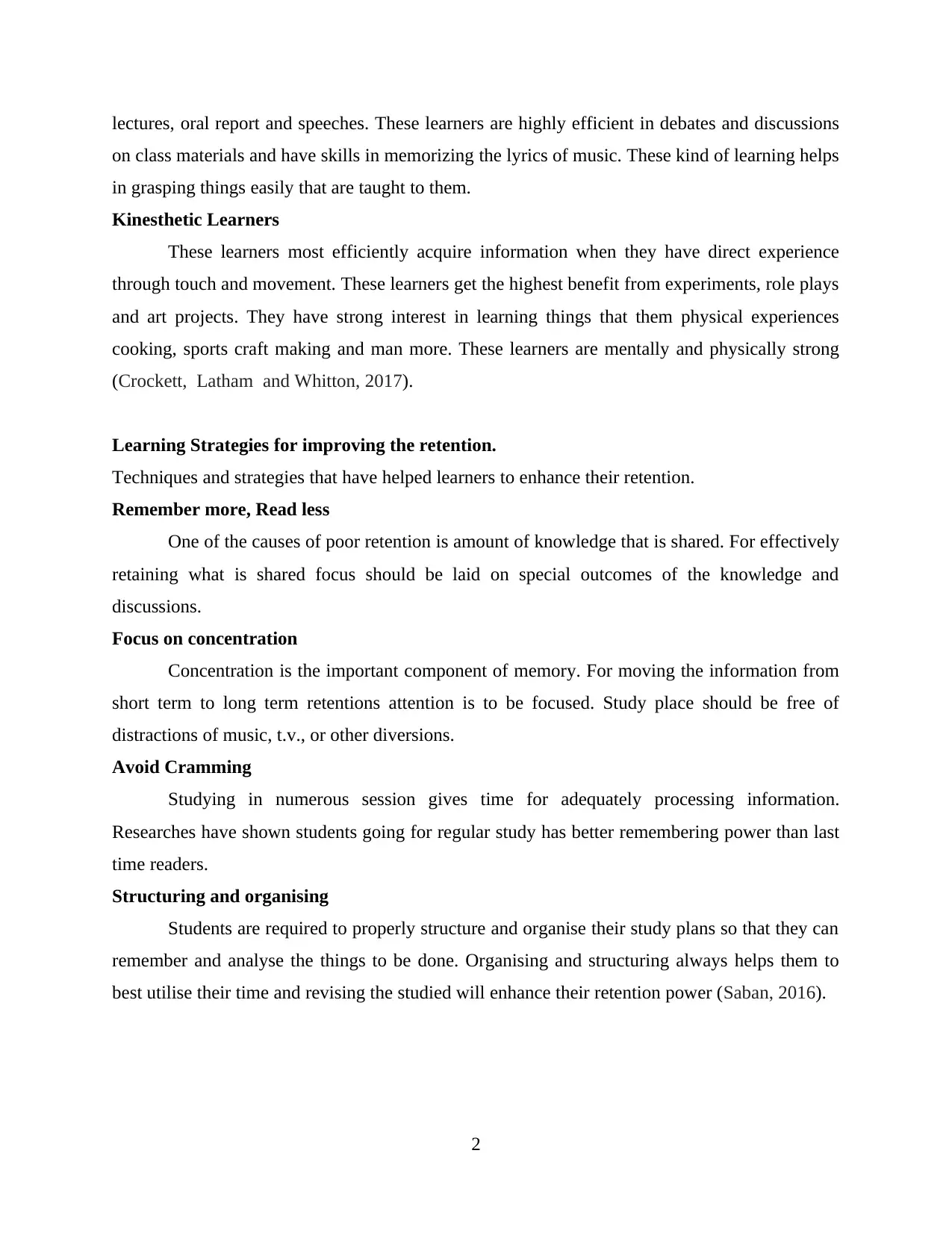
lectures, oral report and speeches. These learners are highly efficient in debates and discussions
on class materials and have skills in memorizing the lyrics of music. These kind of learning helps
in grasping things easily that are taught to them.
Kinesthetic Learners
These learners most efficiently acquire information when they have direct experience
through touch and movement. These learners get the highest benefit from experiments, role plays
and art projects. They have strong interest in learning things that them physical experiences
cooking, sports craft making and man more. These learners are mentally and physically strong
(Crockett, Latham and Whitton, 2017).
Learning Strategies for improving the retention.
Techniques and strategies that have helped learners to enhance their retention.
Remember more, Read less
One of the causes of poor retention is amount of knowledge that is shared. For effectively
retaining what is shared focus should be laid on special outcomes of the knowledge and
discussions.
Focus on concentration
Concentration is the important component of memory. For moving the information from
short term to long term retentions attention is to be focused. Study place should be free of
distractions of music, t.v., or other diversions.
Avoid Cramming
Studying in numerous session gives time for adequately processing information.
Researches have shown students going for regular study has better remembering power than last
time readers.
Structuring and organising
Students are required to properly structure and organise their study plans so that they can
remember and analyse the things to be done. Organising and structuring always helps them to
best utilise their time and revising the studied will enhance their retention power (Saban, 2016).
2
on class materials and have skills in memorizing the lyrics of music. These kind of learning helps
in grasping things easily that are taught to them.
Kinesthetic Learners
These learners most efficiently acquire information when they have direct experience
through touch and movement. These learners get the highest benefit from experiments, role plays
and art projects. They have strong interest in learning things that them physical experiences
cooking, sports craft making and man more. These learners are mentally and physically strong
(Crockett, Latham and Whitton, 2017).
Learning Strategies for improving the retention.
Techniques and strategies that have helped learners to enhance their retention.
Remember more, Read less
One of the causes of poor retention is amount of knowledge that is shared. For effectively
retaining what is shared focus should be laid on special outcomes of the knowledge and
discussions.
Focus on concentration
Concentration is the important component of memory. For moving the information from
short term to long term retentions attention is to be focused. Study place should be free of
distractions of music, t.v., or other diversions.
Avoid Cramming
Studying in numerous session gives time for adequately processing information.
Researches have shown students going for regular study has better remembering power than last
time readers.
Structuring and organising
Students are required to properly structure and organise their study plans so that they can
remember and analyse the things to be done. Organising and structuring always helps them to
best utilise their time and revising the studied will enhance their retention power (Saban, 2016).
2
Paraphrase This Document
Need a fresh take? Get an instant paraphrase of this document with our AI Paraphraser
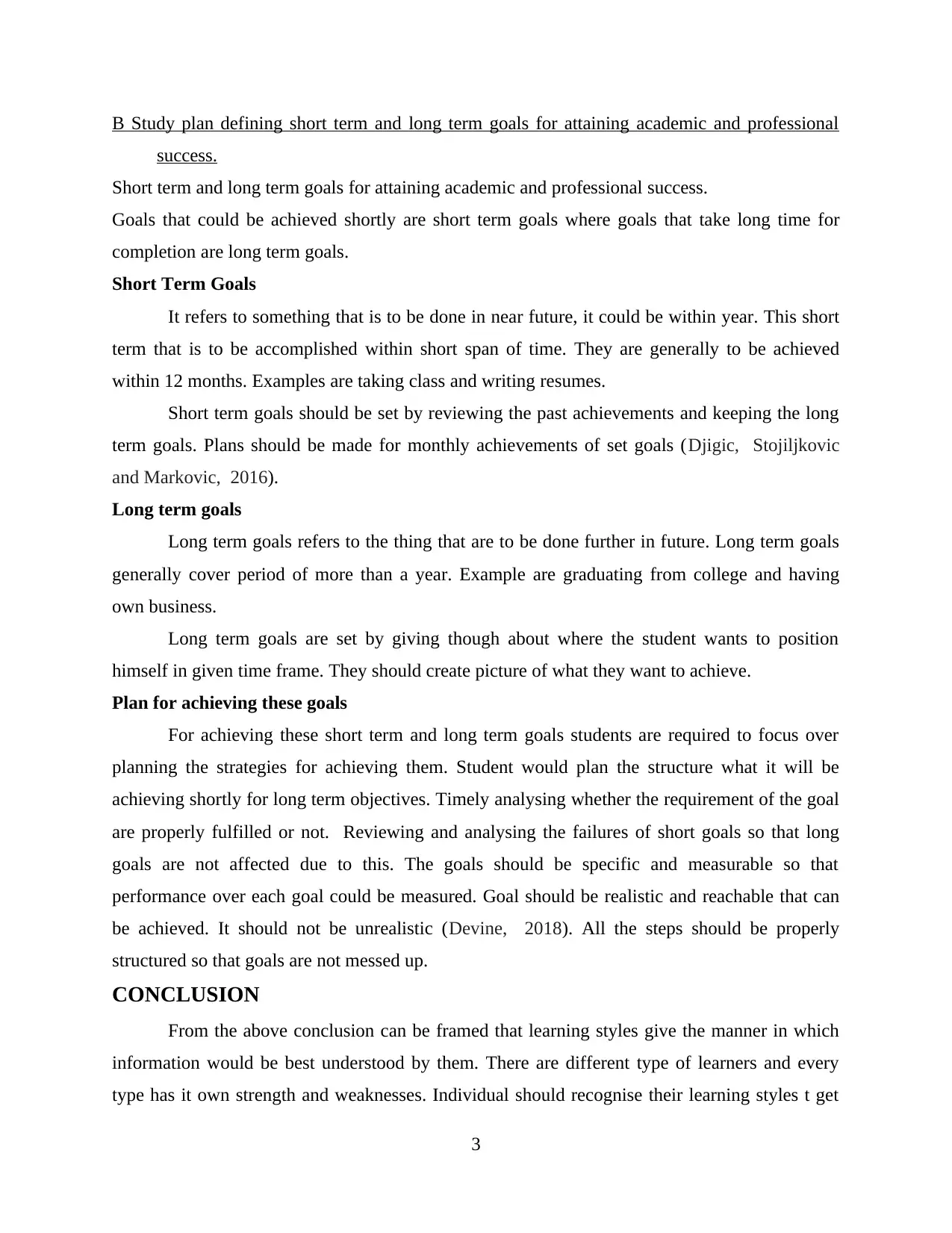
B Study plan defining short term and long term goals for attaining academic and professional
success.
Short term and long term goals for attaining academic and professional success.
Goals that could be achieved shortly are short term goals where goals that take long time for
completion are long term goals.
Short Term Goals
It refers to something that is to be done in near future, it could be within year. This short
term that is to be accomplished within short span of time. They are generally to be achieved
within 12 months. Examples are taking class and writing resumes.
Short term goals should be set by reviewing the past achievements and keeping the long
term goals. Plans should be made for monthly achievements of set goals (Djigic, Stojiljkovic
and Markovic, 2016).
Long term goals
Long term goals refers to the thing that are to be done further in future. Long term goals
generally cover period of more than a year. Example are graduating from college and having
own business.
Long term goals are set by giving though about where the student wants to position
himself in given time frame. They should create picture of what they want to achieve.
Plan for achieving these goals
For achieving these short term and long term goals students are required to focus over
planning the strategies for achieving them. Student would plan the structure what it will be
achieving shortly for long term objectives. Timely analysing whether the requirement of the goal
are properly fulfilled or not. Reviewing and analysing the failures of short goals so that long
goals are not affected due to this. The goals should be specific and measurable so that
performance over each goal could be measured. Goal should be realistic and reachable that can
be achieved. It should not be unrealistic (Devine, 2018). All the steps should be properly
structured so that goals are not messed up.
CONCLUSION
From the above conclusion can be framed that learning styles give the manner in which
information would be best understood by them. There are different type of learners and every
type has it own strength and weaknesses. Individual should recognise their learning styles t get
3
success.
Short term and long term goals for attaining academic and professional success.
Goals that could be achieved shortly are short term goals where goals that take long time for
completion are long term goals.
Short Term Goals
It refers to something that is to be done in near future, it could be within year. This short
term that is to be accomplished within short span of time. They are generally to be achieved
within 12 months. Examples are taking class and writing resumes.
Short term goals should be set by reviewing the past achievements and keeping the long
term goals. Plans should be made for monthly achievements of set goals (Djigic, Stojiljkovic
and Markovic, 2016).
Long term goals
Long term goals refers to the thing that are to be done further in future. Long term goals
generally cover period of more than a year. Example are graduating from college and having
own business.
Long term goals are set by giving though about where the student wants to position
himself in given time frame. They should create picture of what they want to achieve.
Plan for achieving these goals
For achieving these short term and long term goals students are required to focus over
planning the strategies for achieving them. Student would plan the structure what it will be
achieving shortly for long term objectives. Timely analysing whether the requirement of the goal
are properly fulfilled or not. Reviewing and analysing the failures of short goals so that long
goals are not affected due to this. The goals should be specific and measurable so that
performance over each goal could be measured. Goal should be realistic and reachable that can
be achieved. It should not be unrealistic (Devine, 2018). All the steps should be properly
structured so that goals are not messed up.
CONCLUSION
From the above conclusion can be framed that learning styles give the manner in which
information would be best understood by them. There are different type of learners and every
type has it own strength and weaknesses. Individual should recognise their learning styles t get
3
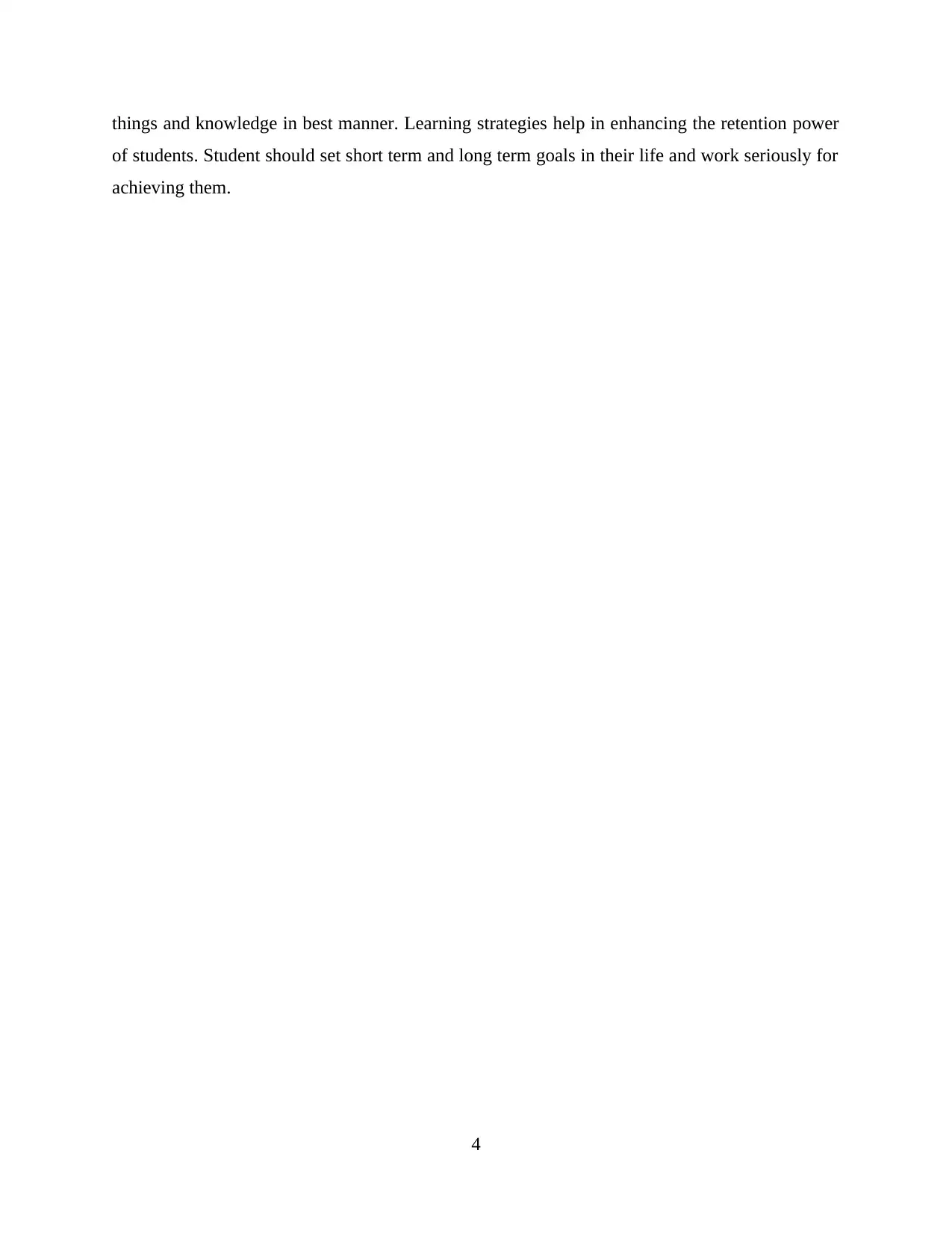
things and knowledge in best manner. Learning strategies help in enhancing the retention power
of students. Student should set short term and long term goals in their life and work seriously for
achieving them.
4
of students. Student should set short term and long term goals in their life and work seriously for
achieving them.
4
⊘ This is a preview!⊘
Do you want full access?
Subscribe today to unlock all pages.

Trusted by 1+ million students worldwide
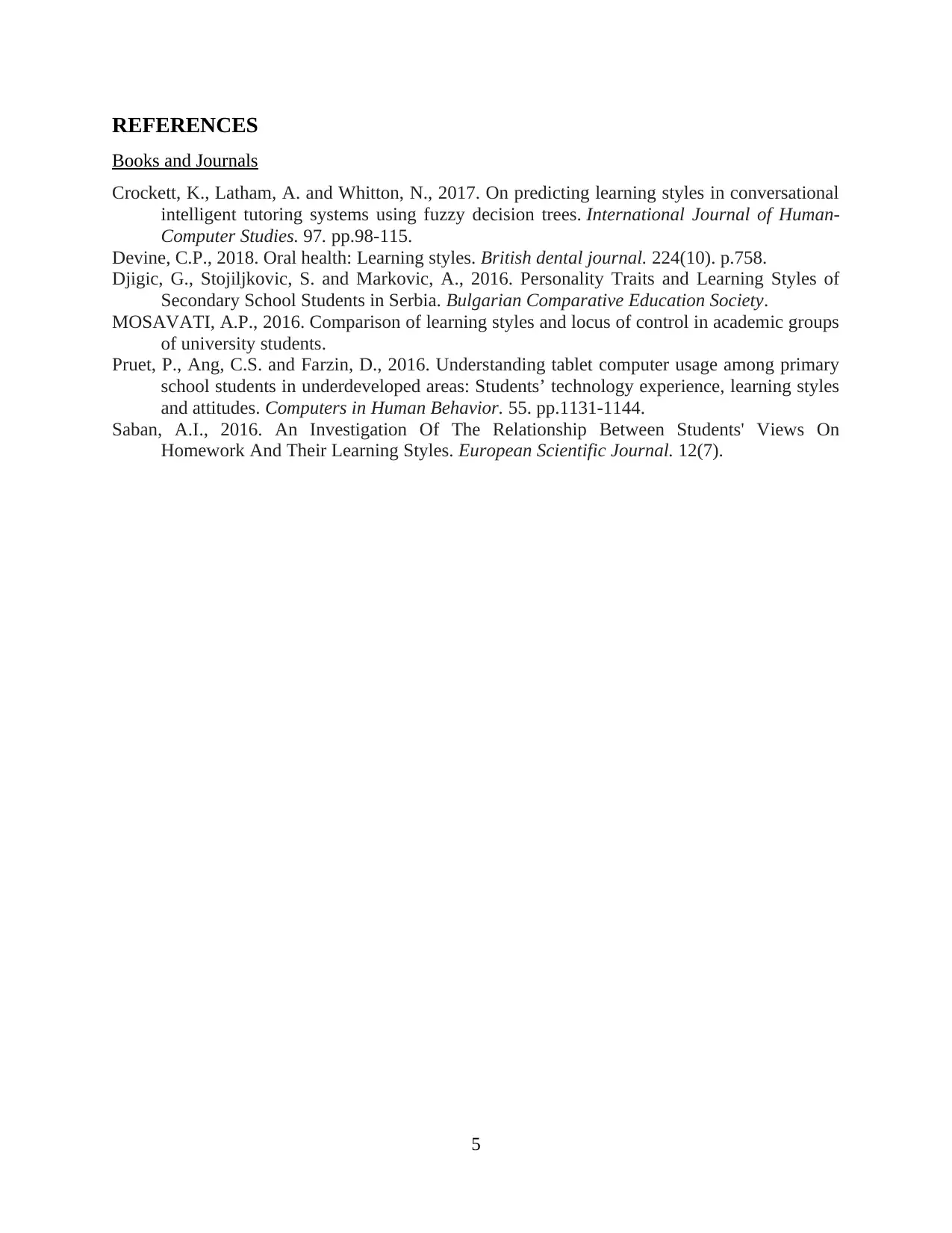
REFERENCES
Books and Journals
Crockett, K., Latham, A. and Whitton, N., 2017. On predicting learning styles in conversational
intelligent tutoring systems using fuzzy decision trees. International Journal of Human-
Computer Studies. 97. pp.98-115.
Devine, C.P., 2018. Oral health: Learning styles. British dental journal. 224(10). p.758.
Djigic, G., Stojiljkovic, S. and Markovic, A., 2016. Personality Traits and Learning Styles of
Secondary School Students in Serbia. Bulgarian Comparative Education Society.
MOSAVATI, A.P., 2016. Comparison of learning styles and locus of control in academic groups
of university students.
Pruet, P., Ang, C.S. and Farzin, D., 2016. Understanding tablet computer usage among primary
school students in underdeveloped areas: Students’ technology experience, learning styles
and attitudes. Computers in Human Behavior. 55. pp.1131-1144.
Saban, A.I., 2016. An Investigation Of The Relationship Between Students' Views On
Homework And Their Learning Styles. European Scientific Journal. 12(7).
5
Books and Journals
Crockett, K., Latham, A. and Whitton, N., 2017. On predicting learning styles in conversational
intelligent tutoring systems using fuzzy decision trees. International Journal of Human-
Computer Studies. 97. pp.98-115.
Devine, C.P., 2018. Oral health: Learning styles. British dental journal. 224(10). p.758.
Djigic, G., Stojiljkovic, S. and Markovic, A., 2016. Personality Traits and Learning Styles of
Secondary School Students in Serbia. Bulgarian Comparative Education Society.
MOSAVATI, A.P., 2016. Comparison of learning styles and locus of control in academic groups
of university students.
Pruet, P., Ang, C.S. and Farzin, D., 2016. Understanding tablet computer usage among primary
school students in underdeveloped areas: Students’ technology experience, learning styles
and attitudes. Computers in Human Behavior. 55. pp.1131-1144.
Saban, A.I., 2016. An Investigation Of The Relationship Between Students' Views On
Homework And Their Learning Styles. European Scientific Journal. 12(7).
5
1 out of 7
Related Documents
Your All-in-One AI-Powered Toolkit for Academic Success.
+13062052269
info@desklib.com
Available 24*7 on WhatsApp / Email
![[object Object]](/_next/static/media/star-bottom.7253800d.svg)
Unlock your academic potential
Copyright © 2020–2025 A2Z Services. All Rights Reserved. Developed and managed by ZUCOL.





